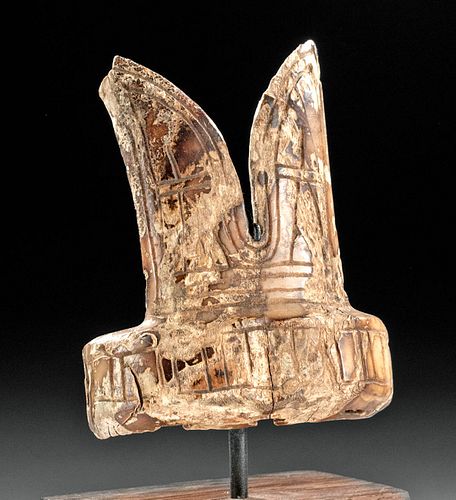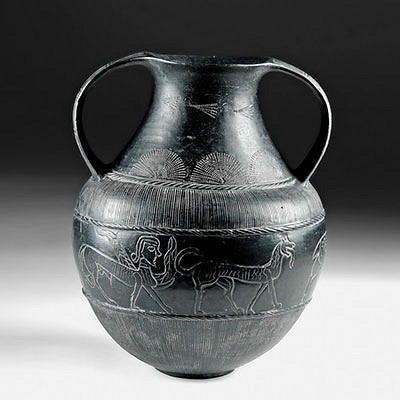First Nations Punuk Thule Walrus Ivory Wrist Guard
Lot 120a
About Seller
Artemis Gallery
686 S Taylor Ave, Ste 106
Louisville, CO 80027
United States
Selling antiquities, ancient and ethnographic art online since 1993, Artemis Gallery specializes in Classical Antiquities (Egyptian, Greek, Roman, Near Eastern), Asian, Pre-Columbian, African / Tribal / Oceanographic art. Our extensive inventory includes pottery, stone, metal, wood, glass and textil...Read more
Estimate:
$3,000 - $4,500
Absentee vs Live bid
Two ways to bid:
- Leave a max absentee bid and the platform will bid on your behalf up to your maximum bid during the live auction.
- Bid live during the auction and your bids will be submitted real-time to the auctioneer.
Bid Increments
| Price | Bid Increment |
|---|---|
| $0 | $25 |
| $300 | $50 |
| $1,000 | $100 |
| $2,000 | $250 |
| $5,000 | $500 |
| $10,000 | $1,000 |
| $20,000 | $2,500 |
| $50,000 | $5,000 |
| $100,000 | $10,000 |
| $200,000 | $20,000 |
About Auction
By Artemis Gallery
Sep 17, 2020
Set Reminder
2020-09-17 10:00:00
2020-09-17 10:00:00
America/New_York
Bidsquare
Bidsquare : CLEARANCE - Ancient, Pre-Columbian, Ethno Art
https://www.bidsquare.com/auctions/artemis-gallery/clearance---ancient-pre-columbian-ethno-art-5605
End-of-Summer Clearance sale featuring discounted pricing on antiquities from Egypt, Greece, Italy, and the Near East...plus Viking, Asian, Pre-Columbian, Tribal, Russian Icons, Spanish Colonial, Fine Art, more! Starting prices have been reduced up to 65% from original auction prices. Artemis Gallery info@artemisgallery.com
End-of-Summer Clearance sale featuring discounted pricing on antiquities from Egypt, Greece, Italy, and the Near East...plus Viking, Asian, Pre-Columbian, Tribal, Russian Icons, Spanish Colonial, Fine Art, more! Starting prices have been reduced up to 65% from original auction prices. Artemis Gallery info@artemisgallery.com
- Lot Description
**Originally Listed At $1750**
Native American / First Nations, coastal Alaska, Thule people, Punuk stage, ca. 800 to 1400 CE. One of my favorites, this is a wrist guard, also known as a brace or a bracer, hand-carved from walrus ivory. It was made to protect an archer's wrist as he or she held a bow from the percussion of the bowstring when released. They are often, as this one, curved plates; this example would have once had straps that held it in place, affixed via the ovoid perforations on the lower band. This one is beautifully patinated, attesting to its great age, with still visible clan marks characteristic of the Punuk style around its lower band and incised motifs on the projecting upper part, its split body reminiscent of two horns rising from a head. Size: 2.3" W x 2.75" H (5.8 cm x 7 cm); 4.75" H (12.1 cm) on included custom stand.
During the Punuk stage, society along the Alaskan coast intensified. People lived in more complex settlements, and built houses with whale jaw-bone supports, and skins, sod, and snow coverings that allowed them to blend into the landscape. Important technological changes occurred as well, notably with the development of a reinforced bow and wrist guards like this one. The Punuk had contacts with people across the Bering Sea in Siberia, and some researchers believe that the new bow technology came from military and trade exchanges with eastern Asia.
Provenance: private Newport Beach, California, USA collection
All items legal to buy/sell under U.S. Statute covering cultural patrimony Code 2600, CHAPTER 14, and are guaranteed to be as described or your money back.
A Certificate of Authenticity will accompany all winning bids.
We ship worldwide and handle all shipping in-house for your convenience.
#148602Extensive patina on surface with wear and small losses commensurate with age and handling. Small fissures in the edges from age. Tiny chip lost from one point, otherwise intact and in great shape for its age.Condition
- Shipping Info
-
All shipping is handled in-house for your convenience. Your invoice from Artemis Gallery will include shipping calculation instructions. If in doubt, please inquire BEFORE bidding for estimated shipping costs for individual items.
-
- Buyer's Premium



 EUR
EUR CAD
CAD AUD
AUD GBP
GBP MXN
MXN HKD
HKD CNY
CNY MYR
MYR SEK
SEK SGD
SGD CHF
CHF THB
THB














